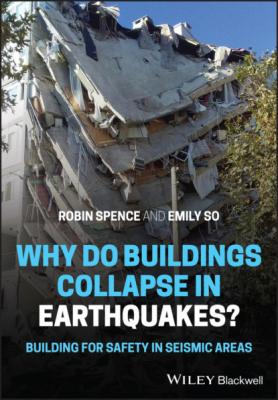Why do buildings collapse in earthquakes? Building for safety in seismic areas. Robin Spence
Чтение книги онлайн.
Читать онлайн книгу Why do buildings collapse in earthquakes? Building for safety in seismic areas - Robin Spence страница 11
 codes of practice for building, as well as assisting in understanding the vulnerability of different types of affected facilities and in developing ways to enhance earthquake safety internationally (EERI 1986; Spence 2014).
codes of practice for building, as well as assisting in understanding the vulnerability of different types of affected facilities and in developing ways to enhance earthquake safety internationally (EERI 1986; Spence 2014).
Both authors have been involved with several EEFIT post‐earthquake reconnaissance missions. Our direct knowledge of the types of buildings affected in earthquakes, and our understanding of their behaviour, is largely derived from these earthquake missions, as well as from some more detailed field investigations and household surveys carried out independently. The following sections give brief accounts of 10 of the most significant earthquakes of the last 20 years, partly based on our own observations, but also making use of the field reports of our colleagues in the EERI and EEFIT teams and other reports. As we are concerned in this book primarily with buildings, these brief accounts emphasise in particular the range of building types which were affected and the levels and types of damage caused, topics which we will return to look at in more detail later in the book. They also touch, where appropriate, on the methods of damage investigation used.
Table 2.1 lists the most significant events of the twenty‐first century up to 2018. It includes all those events which, according to the EM‐DAT database, killed more than 4000 people, and also all those which had a damage cost exceeding US$3.9bn. The 10 events briefly described here include the 9 events with the highest casualty tolls of the last 20 years, and one other event, the New Zealand Christchurch event of 2011. This was particularly significant not for its casualties, which were relatively low, but for the very high financial cost of the damage caused, and for its particular impact on the historic masonry buildings of the city of Christchurch.
The chapter concludes with some general observations about earthquake damage, an assessment of global damage trends and the distribution of damage between different regions and country groups. In this way, we aim to approach an assessment of the question: how well are we, as an international community, doing in trying to limit the effects of earthquakes for this and future generations?
2.2 Significant Earthquakes Since 2000
2.2.1 The 26.1.2001 Bhuj Earthquake: Mw7.7, 13 481 Deaths
At 8.46 a.m. on 26 January 2001, India's 52nd Republic Day, one of the most devastating earthquakes ever to strike India occurred in the Kutch Region of Gujarat State. The earthquake of moment magnitude Mw7.7 and focal depth 23 km was located approximately 70 km east of the historic city of Bhuj. Heavy ground shaking affected an area of tens of thousands of square kilometres, although there was no surface fault rupture observed. The isoseismal map prepared by the EERI team indicates that the area subject to shaking at a level exceeding MM Intensity VIII (‘heavily damaging’) was over 30 000 km2 (Jain et al. 2002). The area has experienced a previous large earthquake (Mw about 8.0) in 1819, and a moderate Mw6.1 one in 1956, and is in the zone with the highest earthquake loading requirements in the Indian code of practice for the design of buildings.
Table 2.1 Significant earthquakes worldwide since 2000, ordered by number of deaths.
Sources: CRED (2020); Pomonis, A., 2020. Personal communication.
| Date | Country | World Bank Income Group | Event | Magnitude (Mw) | Total deaths | Total damage (US$bn) | Insured losses (US$bn) | Percent insured |
|---|---|---|---|---|---|---|---|---|
| 26/12/2004 | Indonesia, Thailand, Sri Lanka, India | UM, LM | Indian Ocean earthquake and tsunami | 9.1 | 225 841 | 7.8 | 0.48 | 6.2 |
| 12/01/2010 | Haiti | L | Haiti | 7.0 | 222 570 | 8 | 0.2 | 2.5 |
| 12/05/2008 | China | UM | Wenchuan | 7.9 | 87 476 | 85 | 0.37 | 0.4 |
| 08/10/2005 | Pakistan | LM | Kashmir | 7.6 | 73 338 | 5.2 | 0 | 0 |
| 26/12/2003 | Iran | UM | Bam | 6.6 | 26 796 | 0.5 | 0 | 0 |
| 26/01/2001 | India | LM | Bhuj | 7.7 | 13 481 | 2.6 | 0.1 | 3.8 |
| 11/03/2011 | Japan | H | Great Tohoku a | 9.1 | >18000 | 210 | 37.5 | 18 |
| 25/04/2015 | Nepal | L | Gorkha | 7.8 | 8 831 | 7.1 | 0.1 | 1.4 |
| 26/05/2006 | Indonesia | UM | Yogyakarta | 6.3 | 5 778 | 3.1 | 0.04 | 1.3 |
| 28/09/2018 | Indonesia | UM | Sulawesi a | 7.5 | 4 340 | 1.5 | 0 | 0 |
| 21/05/2003 | Algeria | UM | Boumerdes | 6.8 | 2 266 |